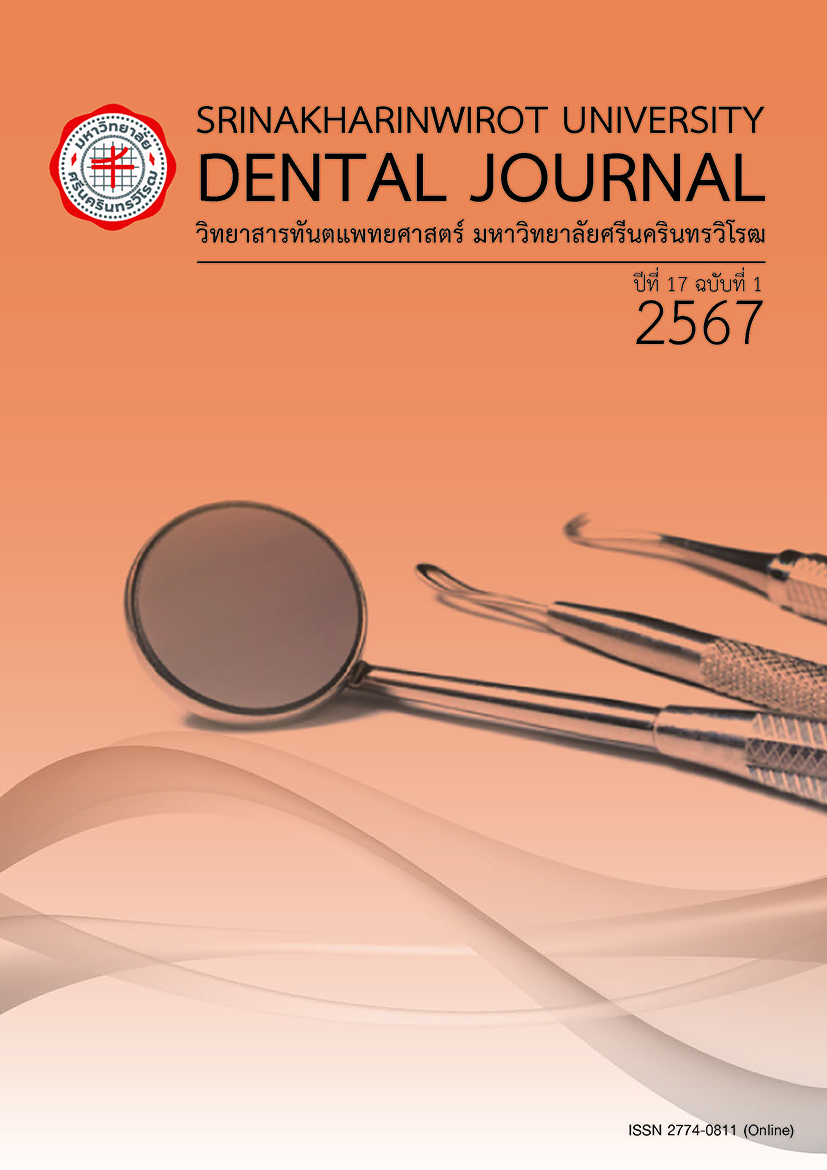ผลของการบ้วนปากหลังการแปรงฟันในการลดแผ่นคราบชีวภาพ
The Effect of Post-Brushing Rinsing on Reducing Dental Biofilm
Keywords:
แผ่นคราบชีวภาพ, คราบจุลินทรีย์, การบ้วนปาก, การแปรงฟัน, การแปรงฟันแบบไม่บ้วนปาก, Dental biofilm, Dental plaque, Mouth rinsing, Toothbrushing, Toothbrushing without rinsingAbstract
วัตถุประสงค์: ศึกษาผลของการบ้วนปากหลังการแปรงฟันต่อการลดแผ่นคราบชีวภาพ วัสดุอุปกรณ์และวิธีการ: ผู้เข้าร่วมการศึกษาจำนวน 36 คน จะได้รับการอบรมเรื่องการแปรงฟัน การขูดหินน้ำลายและขัดฟันในการนัดครั้งที่ 1 งดการทำความสะอาดช่องปากใด ๆ เป็นเวลา 24 ชั่วโมง ก่อนวันนัดครั้งที่ 2 แล้วให้แปรงฟันตามวิธีที่จับฉลากได้ ซึ่งแบ่งเป็น 2 วิธีการ คือ การแปรงฟันแบบไม่บ้วนปาก และการแปรงฟันแล้วบ้วนปาก ตรวจดัชนีคราบจุลินทรีย์ทันที และหลังจากผ่านไป 5 นาที ขูดหินน้ำลายและขัดฟันงดการทำความสะอาดช่องปากใด ๆ เป็นเวลา 24 ชั่วโมง ก่อนวันนัดครั้งที่ 3 แล้วทำการศึกษาเช่นเดียวกับการนัดครั้งที่ 2 ผลการศึกษา: แบ่งกลุ่มที่แปรงฟันแบบไม่บ้วนปากและกลุ่มที่แปรงฟันแล้วบ้วนปาก ทั้ง 2 กลุ่ม มีข้อมูล 3 ชุด ชุดที่ 1 ก่อนการแปรงฟัน ชุดที่ 2 หลังการแปรงฟันทันที ชุดที่ 3 หลังการแปรงฟัน 5 นาที ในแต่ละชุดประกอบไปด้วย ด้านแก้ม ด้านลิ้น ฟันหน้า ฟันหลัง ซึ่งประกอบไปด้วยทั้งหมดของด้านนั้น ๆ ขอบเหงือก และด้านประชิด พบว่าดัชนีคราบจุลินทรีย์ของ 2 กลุ่ม มีค่าลดลงอย่างมีนัยสำคัญทางสถิติ และไม่แตกต่างกันทั้งสองกลุ่มในทุกด้าน ยกเว้นด้านประชิดเมื่อวัดผลหลังแปรงฟันทันที และเมื่อเวลาผ่านไปไว้ 5 นาที คราบจุลินทรีย์ด้านประชิดลดลงอีก จนเกิดความแตกต่างอย่างมีนัยสำคัญทางสถิติเมื่อเทียบกับค่าเริ่มต้น พบความแตกต่างกันอย่างมีนัยสำคัญทางสถิติที่บริเวณขอบเหงือกของฟันหน้า ณ เวลาทันทีและ 5 นาทีหลังจากแปรงฟันแบบไม่บ้วนปากเมื่อเทียบกับแบบบ้วนปาก ที่ p-value < 0.05 สรุป: การแปรงฟันลดคราบจุลินทรีย์ได้อย่างมีนัยสำคัญทางสถิติ แต่การบ้วนปากหลังการแปรงฟันไม่ช่วยลดคราบจุลินทรีย์ที่ยึดกับผิวฟัน Objective: To study the effects of brushing with rinsing on reducing dental biofilm. Materials and Methods: Thirty-six participants received training on toothbrushing, supragingival scaling, and tooth polishing during the first appointment. They were instructed to refrain from any oral hygiene care for 24 hours before the second appointment. For the second visit, each participant brushed their teeth according to the drawing method which is toothbrushing without rinsing and with rinsing. The plaque index was recorded immediately, after five minutes and tooth prophylaxis was accomplished right after. Prior to the third visit, 24 hours without oral hygiene care and the same procedure as the second visit was followed. Results: The study included two groups: toothbrushing without rinsing and toothbrushing with rinsing. Both groups provided data for three sets: Set 1 pre-brushing, Set 2 immediately post-brushing, and Set 3 post-5-minute brushing. Each set was done on buccal, lingual, anterior, posterior which is composed of total area of that aspect, marginal and proximal area. Statistical analysis revealed a significant reduction in dental plaque indices for both groups, with no significant differences observed between the two groups in all aspects except for the gingival margin immediately post-brushing. However, after a 5-minute interval, dental plaque on the gingival margin significantly decreased, demonstrating a statistically significant difference when compared to the baseline values. Notably, there were statistically significant differences at the gingival margin of the anterior teeth immediately and 5 minutes after toothbrushing when comparing rinsing without rinsing with a p-value < 0.05. Conclusion: Toothbrushing significantly reduces dental plaque, but rinsing after toothbrushing does not contribute to a further reduction in plaque adhering to tooth surfaces.Downloads
References
Mazhari F, Boskabady M, Moeintaghavi A, Habibi A. The effect of toothbrushing and flossing sequence on interdental plaque reduction and fluoride retention: A randomized controlled clinical trial. J Periodontol. 2018;89(7):824–32.
Pitts N, Duckworth RM, Marsh P, Mutti B, Parnell C, Zero D. Post-brushing rinsing for the control of dental caries: Exploration of the available evidence to establish what advice we should give our patients. Br Dent J. 2012;212(7):315-20.
Van der Sluijs E, Slot DE, Hennequin-Hoenderdos NL, Van Leeuwen MPC, Van der Weijden GA. Prebrushing rinse with water on plaque removal: A split-mouth design. Int J Dent Hyg. 2017;15(4):345-51.
Prasad M, Patthi B, Singla A, Gupta R, Jankiram C, Kumar JK, Vashishtha V, Malhi R. The clinical effectiveness of post-brushing rinsing in reducing plaque and gingivitis: A systematic review. J Clin Diagn Res. 2016;10:1-7.
Lemeshow S, Hosmer Jr WD, Klar J, Lwanga KS. Adequacy of sample size in health studies. West Sussex: John Wiley & Sons Ltd. 1990. p.39.
Suhasini JS, Valiathan M. Brushing techniques. Eur J Mol Clin Med. 2020;7(iss 2):6601-11.
ADA. Brushing your teeth. (Online) Available: https://www.mouthhealthy.org/en/aztopics/b/brushing-your-teeth. 2012; Accessed [20/6/2022].
Rustogi KN, Curtis JP, Volpe AR, Kemp JH, McCool JJ, Korn LR. Refinement of the modified navy plaque index to increase plaque scoring efficiency in gumline and interproximal tooth areas. J Clin Dent. 1992;3 (Suppl C):C9-12.
Dentalhealth Oragnization. “Spit don’t rinse” for better oral health; 2016 [cited 2023 March]. Avaliable from: URL: https://www.dentalhealth.org/news/spit-dont-rinse-for-better-oralhealth.
University of California San Francisco. Don’t rinse after brushing and other tips for better dental health; 2019 [cited 2023 March]. Avaliable from: URL: https://oralhealthsupport.ucsf.edu/news/dont-rinse-after-brushing-and-other-tipsbetter-dental-health.
Löe H, Theilade E, Jensen SB. Experimental gingivitis in man. J Periodontol. 1965;36(3):177-87.
Marsh PD, Bradshaw DJ. Dental plaque as a biofilm. J Ind Microbiol. 1995;15(iss 3):169-75.
Cugini M, Thompson M, Warren PR. Correlations between two plaque indices in assessment of toothbrush effectiveness. J Contemp Dent Pract. 2006;7(5):1-9.
Alanazi KJ, Subhan SA, Alshehri HM, Aljaload MM, Aljafary MH, Alazmi MM, et al. Influence of tooth brush grips and brushing techniques on plaque removal efficacy. J Dent Oral Health. 2017;4:1-7.
Poyato-Ferrera M, Segura-Egea JJ, Bullón-Fernández P. Comparison of modified Bass technique with normal toothbrushing practices for efficacy in supragingival plaque removal. Int J Dent Hyg. 2003;1(2):110-4.
Terézhalmy GT, Bartizek RD, Biesbrock AR. Plaque-removal efficacy of four types of dental floss. J Periodontol. 2008;79(iss 2):245-51.
Torkzaban P, Arabi SR, Sabounchi SS, Roshanaei G. The efficacy of brushing and flossing sequence on control of plaque and gingival inflammation. Oral Health Prev Dent. 2015;13(3):267-73.
Pitts N, Marsh PD, Mutti B, Parnell C. Post-brushing rinsing for the control of dental caries: Exploration of the available evidence to establish what advice we should give our patients. Br Dent J. 2012;212(7):315-20.
Downloads
Published
How to Cite
Issue
Section
Categories
License
Copyright (c) 2024 Srinakharinwirot University Dental Journal (E-ISSN 2774-0811)

This work is licensed under a Creative Commons Attribution-NonCommercial-NoDerivatives 4.0 International License.
เจ้าของบทความต้องมอบลิขสิทธิ์ในการตีพิมพ์แก่วิทยาสาร โดยเขียนเป็นลายลักษณ์อักษรแนบมาพร้อมบทความที่ส่งมาตีพิมพ์ ตามแบบฟอร์ม "The cover letter format" รวมทั้งต้องมีลายมือชื่อของผู้เขียนทุกท่านรับรองว่าบทความดังกล่าวส่งมาตีพิมพ์ที่วิทยาสารนี้แห่งเดียวเท่านั้น




